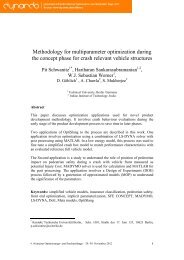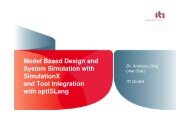multiPlas - Dynardo GmbH
multiPlas - Dynardo GmbH
multiPlas - Dynardo GmbH
You also want an ePaper? Increase the reach of your titles
YUMPU automatically turns print PDFs into web optimized ePapers that Google loves.
F1 (F11) Tension failure brick<br />
F2 (F12) Compressive failure masonry<br />
F3 (F13) Shear failure masonry (brick failure)<br />
F4 (F14) Tension failure parallel to bed joint (brick failure)<br />
F5 (F15) Shear failure masonry<br />
F6 Shear failure bed joint<br />
F7 Tension failure bed joint<br />
F8 (F16) Tension failure bed joint under high horizontal pressure<br />
F9 (F17) Staircase-shaped shear failure<br />
F10 (F18) Tension failure of masonry parallel to bed joints (joint failure)<br />
Tab. 3-2 Material model for masonry – meaning of the flow criteria<br />
The orthotropic nonlinear stress-strain behaviour of masonry is described using the corresponding<br />
softening and hardening models [6-17].<br />
3.3.7.1 Nonlinear stress-strain relation under pressure load<br />
For simulation of a nonlinear stress-strain relation under pressure load two models are available (s. Fig.<br />
3-18). The stress-strain relation complies with the DIN 1045-1 [Law 22] model for concrete shown in<br />
chapter 3.3.6.1 which also applies for vertical pressure load.<br />
The model [Law 20] within Fig. 3-18 is often sufficiently accurate for practical applications.<br />
Fig. 3-18 models of the stress-strain relation in case of pressure load, above: LAW 20, below: LAW<br />
22<br />
23<br />
USER’S MANUAL, January, 2013






